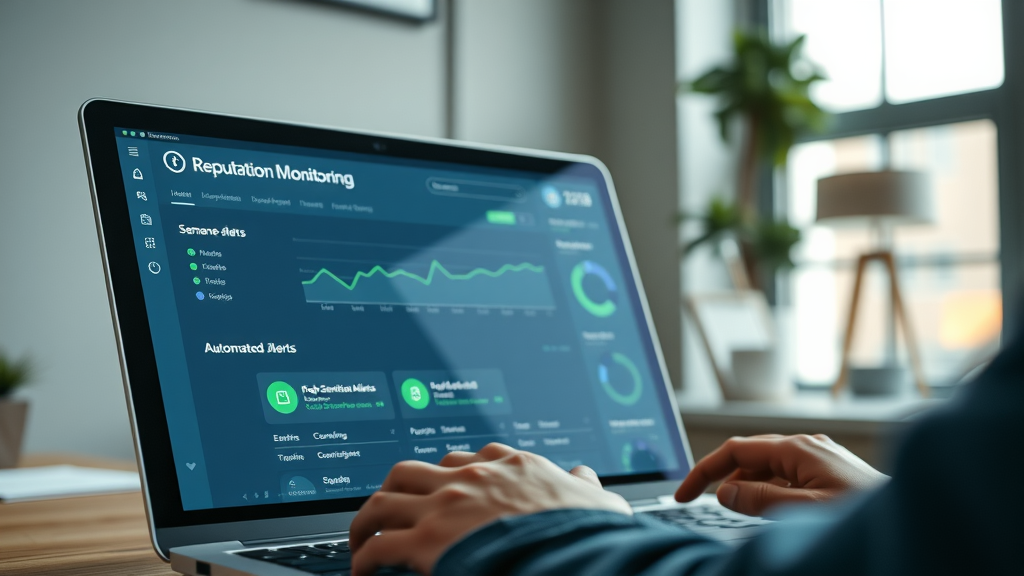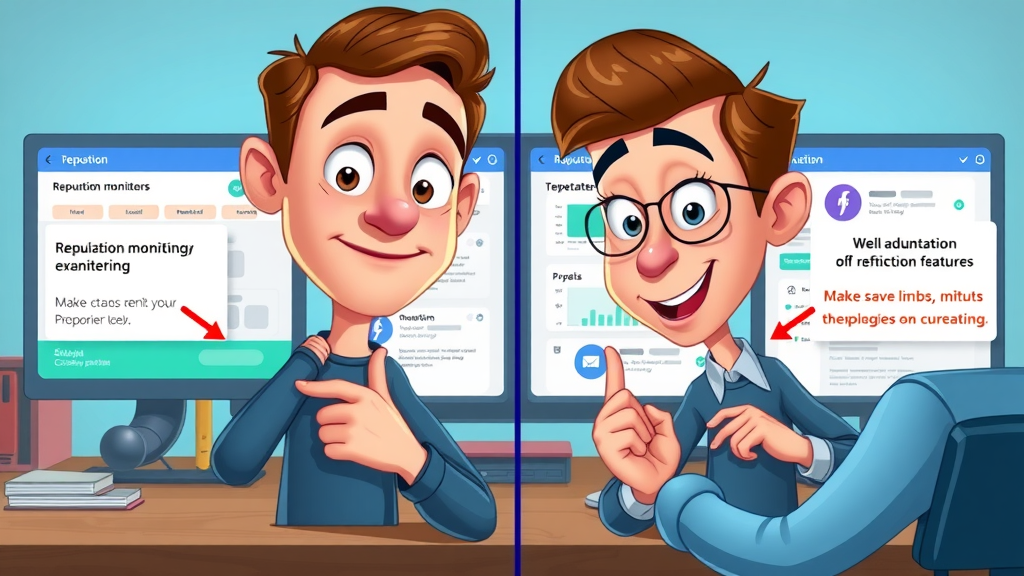
Did you know that the majority of business crises start with a single negative review or unnoticed online mention? In fact, 85% of consumers trust online reviews as much as personal recommendations —meaning your brand’s success hinges on your ability to swiftly spot and address online sentiment. If you’re not monitoring your reputation, you’re already risking your competitive edge. This guide will show you exactly how brand reputation monitoring keeps you ahead of controversy, builds trust, and safeguards your business growth.
Why Brand Reputation Monitoring Matters: The Unseen Risk of Delay
Brand reputation monitoring is more than a buzzword—it’s your safety net against reputational and financial fallout. Today, a single unnoticed comment on a review site or viral post can ignite a chain reaction, damaging your brand awareness almost overnight. With most customers researching brands via online reviews and social media, even a delayed response to an online review can erode trust and push potential customers toward your competitors.
The real danger isn’t just negative reviews themselves but missing early warning signs that allow issues to escalate. Delays in identifying and responding to feedback not only extend the life of a negative review but make it more likely to be amplified across multiple platforms through social media and review sites. In an age where every customer voice echoes across the digital landscape, businesses must be vigilant to preserve their online presence.
Brand Reputation Monitoring: The Cost of Missing Early Signals
Did you know? 85% of consumers trust online reviews as much as personal recommendations—one overlooked review could cost you thousands.
Waiting to act on negative feedback can lead to costly consequences: lost sales, diminished brand loyalty, and lower rankings on crucial search results. For example, a negative review on a major platform can quickly turn into a social media firestorm. Companies without proactive online reputation monitoring tools risk losing control over the narrative, potentially facing a long road to recovery for their online reputation.
On the other hand, early intervention through automated alerts and real-time social listening helps brands build credibility, improve customer satisfaction, and prevent small issues from snowballing. Investing in monitoring software with reputation management features ensures your business can react quickly and maintain a positive online rep in the eyes of potential customers and stakeholders.
What You Need to Know About Brand Reputation Monitoring
- The significance of monitoring tools for real-time reputation management
- How reputation monitoring software streamlines online reputation tracking
- Impact of negative reviews and online reputation management strategies
- Use of sentiment analysis , social listening , and review management in building brand awareness

Brand reputation monitoring tools act as your brand’s first line of defense. These monitoring tools scan the web for mentions of your brand, online reviews, and social media conversations—alerting you instantly when an issue arises. Reputation monitoring software consolidates these insights into a manageable dashboard, making it easy to track customer sentiment, spot trends, and address issues proactively. With the explosion of review sites and user-generated content, automation is no longer a luxury but a necessity to maintain a resilient online rep.
Powerful features like sentiment analysis and social listening ensure that your brand can interpret the tone and context of online discussions, not just flag keywords. Integrating these insights with review management and customer feedback systems provides a holistic view of your brand’s health, empowering your team to take meaningful action and strengthen brand awareness in every digital interaction.
How Brand Reputation Monitoring Supports Proactive Reputation Management
Proactive reputation management hinges on real-time data and insights. Brand reputation monitoring enables your business to spot negative trends, encourage positive customer reviews, and sustain a favorable brand image before issues spiral out of control. With the right monitoring tools, you can configure instant alerts for negative reviews or spikes in negative sentiment, guaranteeing that potential problems are never ignored.
Online reputation monitoring also streamlines your crisis response. When your team is equipped with up-to-the-minute information from monitoring software, you can coordinate resources across marketing, PR, and customer service to respond quickly and effectively. The result? Enhanced resilience, stronger customer loyalty, and competitive differentiation that supports long-term business growth.
Integrating Online Reputation Monitoring into Your Workflow
To get the most from online reputation monitoring, integration is key. Embed monitoring tools directly into your daily workflow for continuous oversight—don’t wait for a crisis to start checking mentions.
This involves linking your monitoring software with platforms you already use, such as customer service CRMs, social media management tools, and review management dashboards. The best reputation monitoring tools offer integrations that automate alerts and streamline cross-team communication, allowing every department to stay informed and take ownership of online reputation management.
With a unified management tool, your brand becomes nimble—able to respond to feedback in real time, collaborate across departments, and shape perception proactively, all from one portal.
Proactive Online Rep Strategies with Monitoring Tools
Adopting a proactive online rep strategy begins by leveraging the full power of monitoring tools to uncover actionable insights. Use sentiment analysis to pinpoint rising issues, and respond publicly (and promptly) to negative reviews.
Set up automated alerts within your monitoring tools to detect brand mentions, whether they’re customer reviews on third-party sites or discussions on social media. This allows you to address complaints swiftly and highlight positive customer feedback in your marketing.
Regularly reviewing analytics provided by your reputation monitoring software will help you track brand awareness trends, ROI from your efforts, and opportunities to celebrate customer satisfaction—making your online rep a valuable asset rather than a risk to be managed.
Choosing the Best Reputation Monitoring Tools for Your Brand
With a crowded marketplace of reputation monitoring software, it’s crucial to choose tools tailored to your unique needs. Consider integrations, the depth of sentiment analysis, review management features, and scalability. Monitoring tools aren’t one-size-fits-all: what works for a small business might not suffice for a multi-location national brand.
Leading solutions in online reputation management offer social listening, automated alerts, seamless integration with customer review and management platforms, and data-driven dashboards that inform business decisions. Investing in the right monitoring tool means fewer missed opportunities, better customer service, and an edge over competitors who rely on manual tracking.
| Software | Key Features | Integrations | Pricing |
|---|---|---|---|
| Brand24 | Social listening, sentiment analysis, automated alerts, review site tracking | Slack, Zapier, Google Analytics | From $49/mo, free trial available |
| Reputation.com | Review management, customer feedback, multi-location management tool | Salesforce, Hootsuite, Zendesk | Custom quotes |
| Hootsuite Insights | Social media monitoring, sentiment analytics, real-time reporting | Facebook, Twitter, Google My Business | From $99/mo |
| Birdeye | Automated survey triggers, online review aggregation, customer service tools | Shopify, HubSpot, Google | From $299/mo |
Key Features of Reputation Monitoring Tools
- Social listening capabilities
- Automated alerts for negative reviews
- Sentiment analysis dashboards
- Integration with review management platforms
- Customer service escalation workflows
Top-tier reputation monitoring software goes beyond basic monitoring to offer sophisticated sentiment analysis dashboards, automated alert configurations for negative reviews, robust social listening, and seamless integration with popular customer service and review management systems. These features ensure a high level of preparedness for any situation involving your online reputation.
By using monitoring tools that are tailored to fit within your current technology stack, your teams gain a real-time view into brand mentions, customer sentiment, and the performance of your online reputation management efforts. This kind of comprehensive oversight drives both improved business outcomes and peace of mind, allowing you to focus on growth.
Online Reputation Monitoring: Monitoring Tools That Make a Difference
Not all monitoring tools are made equal. To truly make a difference, your online reputation monitoring tools should provide actionable, actionable insights—not just raw data. They must be designed specifically to handle the unique dynamics of digital brand management, not just general monitoring functions.
Specialized reputation monitoring software distinguishes itself with features like advanced review management, granular sentiment analysis, and cross-platform coverage (including niche review sites and all major social channels). Such tools empower businesses to maintain an impeccable online presence and resolve online reviews and complaints before they impact potential customers.
Reputation Monitoring Tool vs. General Monitoring Software

The line between reputation monitoring tool and generic monitoring software isn’t always obvious until you need to act fast. General monitoring software may track web mentions, but reputation monitoring tools aggregate customer reviews, facilitate real-time customer service escalation, and automate responses—all while supporting multi-location brand awareness efforts.
For instance, a typical monitoring tool might alert you when your brand is mentioned in a blog post. A purpose-built reputation monitoring solution will not only notify your team of a negative review but also score its sentiment, suggest a response based on best practices, and record outcomes for post-crisis learning. In other words, it supports a full reputation management workflow—not just passive monitoring.
Real-World Examples: How Top Brands Use Reputation Management Software
Top brands consistently leverage reputation management software for both crisis prevention and brand building. For example, a global retailer may use comprehensive social listening technology to track customer sentiment, allowing it to identify and defuse brewing controversies on social media before they reach mass attention. Meanwhile, a franchise restaurant chain integrates review management software to respond to every customer review within minutes, boosting their online ratings and customer loyalty.
In both cases, the outcome is clear: reputation monitoring tools are central to growing brand awareness, maintaining top-notch customer service, and turning every customer interaction into an opportunity for positive engagement.
Social Listening & Sentiment Analysis in Brand Reputation Monitoring
Social listening and sentiment analysis are indispensable for any brand reputation monitoring strategy. Social listening enables brands to capture the full context of conversations happening on social media, forums, and review sites. Sentiment analysis interprets not just what is being said about your brand but how it’s being said—highlighting emerging trends, pain points, and ambassador voices within your customer base.
Combined, these functions within reputation monitoring software ensure that brands can respond dynamically—not just reactively—to evolving customer sentiment. When you’re able to quantify shifts in public opinion, it becomes much easier to prioritize which issues demand immediate attention and which can be resolved through standard online reputation management processes.
Harnessing Social Media for Reputation Management

Social media amplifies both positive and negative experiences. With the right monitoring tool, brands can identify trending hashtags, viral customer posts, and influencer mentions in real time. Social listening features in reputation monitoring software contribute by flagging sentiment shifts in brand-related conversations across all major social media networks.
This rapid insight means reputation management doesn’t have to be reactive—your team can get ahead of potential crises before they escalate. For example, when a negative customer review starts gaining traction online, automated notifications through monitoring software allow for immediate escalation and efficient resolution, enhancing online reputation and strengthening brand awareness within your industry.
Sentiment Analysis: Detecting Issues Before They Escalate
"A single negative review, left unchecked, can spread across platforms and damage your online reputation overnight.” - Senior Brand Manager, Global Retailer
Sentiment analysis uses artificial intelligence and machine learning to identify negative, neutral, or positive tones in online discussions about your brand. With ongoing sentiment monitoring, reputation management teams are able to detect simmering discontent or emerging brand advocates—providing the kind of insight that manual reviews would miss.
By deploying monitoring tools that include advanced sentiment analysis, your business is equipped to intercept negative reviews before they spread, increase customer satisfaction, and drive data-informed improvements to customer service processes. This results in a more resilient and well-regarded online rep over time.
Measuring Success: KPIs for Brand Reputation Monitoring
To understand whether your reputation management efforts are producing results, it’s critical to track the right KPIs (Key Performance Indicators). These metrics should cover everything from brand awareness and customer sentiment to response times and engagement levels on review sites and social channels. Your reputation monitoring software should offer robust analytics dashboards tailored around these business-critical indicators.
Regular KPI reviews allow for timely pivots in strategy—ensuring your team acts on real, actionable data rather than assumptions. This not only supports online reputation management but also empowers ongoing business growth informed by reliable customer feedback and insights gleaned from monitoring tools.
| KPI Metric | Calculation | Importance | Tool Example |
|---|---|---|---|
| Net Promoter Score (NPS) | Customer survey responses (Promoters - Detractors) | Measures customer loyalty and satisfaction | Birdeye, Reputation.com |
| Average Review Rating | Sum of ratings / Number of reviews | Indicates customer satisfaction and online rep | Brand24, Hootsuite Insights |
| Response Time | Time from review/mention to brand response | Impacts customer trust and service | Reputation.com, Brand24 |
| Sentiment Score | Automated sentiment analysis (positive/neutral/negative) | Tracks shifts in brand perception | Brand24, Hootsuite Insights |
| Share of Voice | Mentions of your brand / Total industry mentions | Measures brand awareness | Brand24, Hootsuite Insights |
Essential Metrics: From Brand Awareness to Customer Service Response
Metrics like NPS, average star ratings, and customer satisfaction survey results are the backbone of effective reputation management. Tracking the volume and quality of customer reviews, speed of responses to online reviews, and share of voice in social media conversations helps brands build a comprehensive picture of their online presence. These essential KPIs are easily customizable within most reputation monitoring tools for effortless tracking and reporting across teams.
Review management workflows should include monthly analytics reviews, ensuring that every department knows where the brand’s online reputation stands and how to improve it further. The integration of monitoring tools with various business systems ensures that data is always current, actionable, and capable of driving real-world change for your brand awareness and customer service outcomes.
Overcoming Common Challenges in Brand Reputation Monitoring
Even with the best monitoring tools, challenges arise—from dealing with negative reviews to maintaining efficiency across distributed teams. Reputation management isn’t simply a matter of responding to every issue: it requires discipline, ongoing training, and clear procedures. Brands must also ensure that data from reputation monitoring software translates into meaningful action so that every customer review and piece of feedback receives appropriate attention.
Integrating customer service, marketing, and PR teams is key for holistic online reputation management. Whether you’re addressing a sudden crisis or preventing slow-burn issues, your reputation monitoring tool should be the central hub for tracking progress, coordinating resources, and ensuring consistency in your brand’s voice everywhere online.
Dealing with Negative Reviews: Reputation Management Best Practices

When negative reviews surface, your response time and tone matter just as much as the solution offered. Best practices include acknowledging the experience, apologizing if necessary, and taking the conversation offline for resolution. Empower your team to monitor all review sites regularly and respond within 24 hours—a standard set by leading online reputation management professionals.
Utilize reputation monitoring software to set up automated notifications when negative reviews are posted, and build templates for common responses to ensure consistency and professionalism. Remember, timely and thoughtful replies demonstrate your brand’s commitment to customer satisfaction—and can often turn negative experiences into powerful testimonials.
Streamlining Team Coordination with Reputation Monitoring Software
Reputation management is a team sport, especially in organizations with multiple locations or active online presences. Reputation monitoring tools with real-time dashboards facilitate seamless communication between departments—ensuring issues are never dropped or mishandled.
Use features like role-based user access, automated task assignments, and integrated reporting to keep every stakeholder in the loop. This workflow removes bottlenecks, maximizes transparency, and creates a united front in managing your online reputation. Streamlined operations mean faster response times and a stronger, more consistent brand voice across all digital channels.
Integrating Brand Reputation Monitoring Across Departments
Brand reputation doesn’t rest solely with your marketing team. For true control, reputation monitoring tools should be embedded across the entire organization—including PR, customer service, product development, and leadership. Each team has a role in interpreting, escalating, or responding to customer feedback, social listening data, and sentiment analysis reports.
Companies with the strongest brand awareness regularly schedule cross-departmental reviews, using shared monitoring dashboards to examine trends and set coordinated action plans. This not only unifies customer service standards but also enables real-time crisis response and consistent messaging across every channel where your audience is active.
Collaboration Between Marketing, PR, and Customer Service
- Ensuring consistent online reputation management
- Real-time crisis response with monitoring tools
- Unified management tool dashboard for all teams
When marketing, PR, and customer service teams collaborate, brands are better equipped to deliver consistent responses and quickly align strategies in the face of emerging threats. Use a unified management tool to bring together insights from sentiment analysis, social listening, and review management—streamlining everything from daily monitoring to major crisis communications. Together, these teams create a powerful brand reputation defense system that maximizes positive online presence and minimizes risk.
People Also Ask
How to measure brand reputation in KPI?
Brand reputation can be measured through targeted Key Performance Indicators (KPIs) such as Net Promoter Score (NPS), average review ratings, sentiment analysis scores, and share of voice. Reputation monitoring tools track these metrics automatically, providing clear data on brand health and helping you quickly identify areas for improvement in your online rep.
How to manage brand reputation?
Managing brand reputation involves monitoring all online mentions, responding promptly to negative reviews, encouraging positive feedback, and actively engaging across social media platforms. Reputation management software and monitoring tools simplify this process by providing real-time alerts, review management features, and data-driven dashboards for continuous improvement.
How to master the 3 pillars of brand reputation management?
Mastering brand reputation management requires expertise in (1) proactive monitoring using top-tier reputation monitoring software, (2) exceptional customer service with clear response protocols, and (3) consistent brand messaging across all digital platforms. Employing monitoring tools ensures each pillar is supported and measurable for business growth.
How is brand reputation calculated?
Brand reputation is calculated by aggregating customer feedback, online reviews, sentiment scores, and overall online presence analytics. Monitoring tools synthesize this data, translating it into actionable scores or dashboards that reflect public perception and provide benchmarks for ongoing reputation management.
Case Studies: Boosting Online Reputation and Brand Awareness
Online Reputation Management for Multi-Location Businesses
- Case study: National food chain using reputation monitoring software
- Results: Increased positive reviews and proactive issue resolution
- Brand awareness impact and improved customer service rankings
"Implementing robust reputation management tools turned our reputation score around within months." - CEO, Hospitality Group
A national food chain struggled with inconsistent customer reviews across dozens of locations, leading to poor rankings on major review sites. By integrating a centralized reputation monitoring tool, the brand unified its online reputation management processes. Automated alerts and sentiment analysis enabled each franchise to address negative reviews within hours, boosting customer satisfaction scores by 40% and increasing positive mentions on social media. In just months, the chain achieved a sustained increase in brand awareness and improved nationwide customer service rankings.
This example underscores the measurable benefits of investing in comprehensive monitoring software—not just for crisis prevention but for shaping positive, lasting perceptions in every market you serve.
Quick-Start Checklist for Brand Reputation Monitoring
- Assess current online rep with monitoring tool
- Set up alerts and sentiment analysis
- Establish response protocols for negative reviews
- Integrate reputation monitoring tools across teams
- Review analytics and adapt strategy monthly
Start your journey by assessing your brand’s digital footprint, installing reputation monitoring software, configuring alerts for reviews and social mentions, and scheduling monthly reviews of analytics. This checklist helps streamline online reputation management for brands of all sizes, ensuring early detection of potential issues and continuous improvement in your online presence.
Frequently Asked Questions
What is the best tool for brand reputation monitoring?
The best tool for brand reputation monitoring depends on your needs, but many businesses prefer solutions like Brand24, Reputation.com, Hootsuite Insights, or Birdeye. These offer advanced review management, sentiment analysis, and automated alerts—empowering teams to maintain a robust online rep with minimal manual effort.
How quickly should I respond to online reviews?
Ideally, brands should respond to online reviews within 24 hours. Rapid responses demonstrate your commitment to customer satisfaction, build trust, and prevent negative experiences from escalating on review sites and social media platforms. Monitoring tools make it feasible by automating alerts and streamlining workflows across teams.
Next Steps: Take Charge of Your Brand Reputation Monitoring
Ready to protect your brand? Schedule a Free Strategy Session Today! https://hub.prospectrocket.com/AR/eymcalendar
- Implement robust reputation monitoring
- Secure your online reputation
- Drive business growth through actionable insights
Actionable Step: Get started with brand reputation monitoring today—schedule your free strategy session now to see how you can transform your online rep and unlock new growth for your business.
To enhance your understanding of brand reputation monitoring, consider exploring the following resources:
-
“8 Tools to Effectively Monitor Your Brand’s Reputation Online” : This article provides an overview of top tools like Google Alerts, Brand24, and Hootsuite, detailing their features and how they can help you track and manage your brand’s online presence. ( name.com )
-
“Online Brand Reputation Monitoring & Management Software - Sprinklr” : This page introduces Sprinklr’s AI-powered reputation management software, which offers real-time sentiment analysis and crisis detection across multiple digital channels. ( sprinklr.com )
These resources offer valuable insights and tools to help you proactively monitor and manage your brand’s reputation, ensuring you can address issues promptly and maintain a positive online presence.
 Add Row
Add Row  Add
Add 




Write A Comment